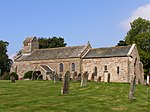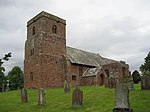All Saints Church, Bolton
Bolton, CumbriaChurch of England church buildings in CumbriaDiocese of CarlisleEnglish Gothic architecture in CumbriaEnglish churches with Norman architecture ... and 2 more
EngvarB from April 2014Grade I listed churches in Cumbria

All Saints Church is in the village of Bolton, Cumbria, England. It is an active Anglican parish church in the deanery of Appleby, the archdeaconry of Carlisle, and the diocese of Carlisle. Its benefice is united with a number of others to form the North Westmorland Benefice. The church is recorded in the National Heritage List for England as a designated Grade I listed building.
Excerpt from the Wikipedia article All Saints Church, Bolton (License: CC BY-SA 3.0, Authors, Images).All Saints Church, Bolton
Edenfold,
Geographical coordinates (GPS) Address External links Nearby Places Show on map
Geographical coordinates (GPS)
| Latitude | Longitude |
|---|---|
| N 54.6046 ° | E -2.5599 ° |
Address
All Saints
Edenfold
CA16 6BQ
England, United Kingdom
Open on Google Maps








